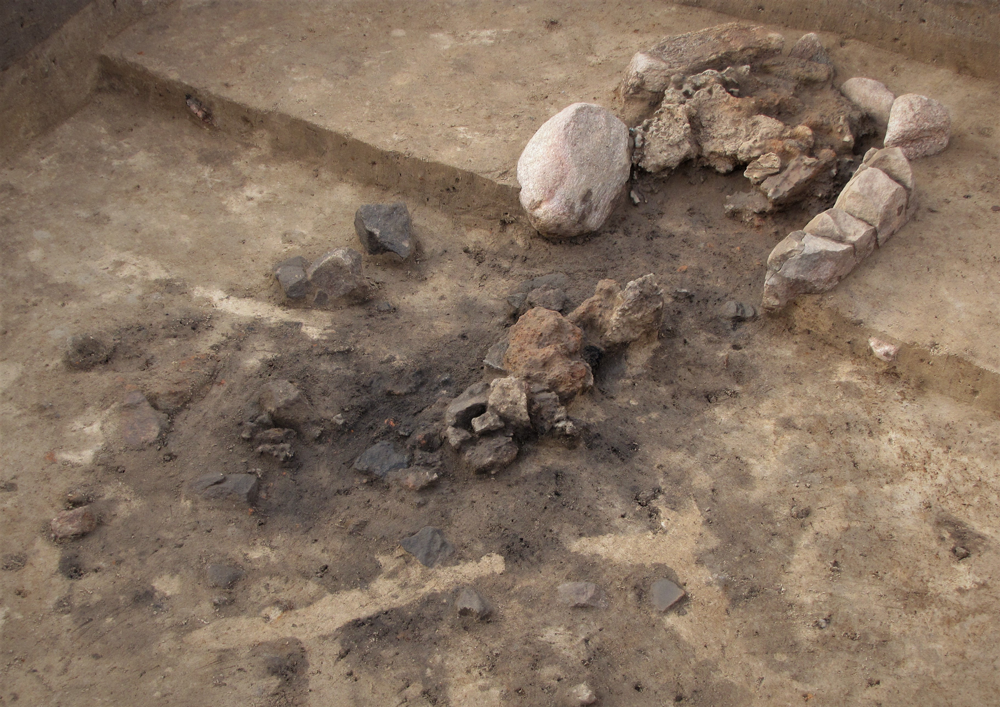The Teltow, a ground moraine south of Berlin, is one of the pioneering regions in early iron smelting in central Europe. Evidence shows that iron has been produced and processed in this region since the fourth century BC (LT B1). Furthermore, there are initial indications that iron smelting technology was introduced as early as the fifth century BC (Ha D/LT A).
Research

Bloomery type “Glienick“ at an test excavation near Mittenwalde. Dating 4./3. century BC | Photo: M. Brumlich, © M. Brumlich)
The research into early iron production in the region has occurred in three stages: The first stage (micro level) used archaeological and geophysical surveys and large-scale excavations to extensively examine a pre-Roman Iron Age settlement with evidence of iron smelting and processing, as part of a previously completed DFG project (Brumlich, Meyer, Lychatz 2011 | Brumlich, Meyer, Lychatz 2012). The second stage (meso level) is part of research project A-5-1 and comprises surveys and small test excavations on a selection of additional settlements with iron metallurgical finds. This project also includes the documentation of all of the Teltow’s Iron Age sites (macro level) in order to extrapolate the structure of the regional iron supply in comparison with the known smelting sites (Bebermeier et al. 2016). In collaboration with the Institute of Iron and Steel Technology, Freiberg (Bernd Lychatz), metallurgical analyses of ores, slags, and bloom fragments are being conducted and economic calculations of production capacity derived from these.
Results
The focus of the studies, however, was not only the material remains of the iron production, but also its grounding in the landscape, as well as the possible impact of metallurgical activities on the environment. The Teltow region, with its considerable natural resources, had high potential for settlement and for the establishment of regional iron smelting. One finding that these studies have shown is that the Teltow had vast areas with conditions that would favor the generation of bog iron ore, which formed the basis of the regional iron production. Another is the emergence of a clear orientation of Iron Age settlement to the presence of boulder clay, a substance which served among other things as a building material for the bloomeries. Calculations of the consumption of raw materials indicated that iron production should not be expected to have had serious effects on the landscape. Palynological examinations (Pim de Klerk) of sediments from the Rangsdorfer Lake confirm this, since pollen profiles showed no recognizable decline in forest stocks for the purpose of fueling metallurgical processes.
At the meso level, geomagnetic surveys (Eastern Atlas Berlin), field prospecting with the calibration of individual finds, and test excavations of seven find sites provided detailed insights into the structure of iron production in the Iron Age settlements of the Teltow. The test excavations on six of these sites showed evidence beyond a shadow of a doubt that bloomeries of the “Glienick” type had been used. This type of bloomery clearly represented the standard in the settlements in the Nuthe-Notte lowlands of the Teltow for a period of several centuries. These settlements are also characterized by massive deposits of refuse from iron smelting and processing. By contrast, the settlements on the northern Teltow plateau likewise provide evidence of local iron production, but to a much lesser degree, and without any indications of the “Glienick” bloomery type thus far. Smaller, freestanding shaft furnaces with slag pits seem to have been used for iron smelting here. The reason for the variations in the structure of iron production within the region could be based on differences in resource availability, since the natural conditions in the Nuthe-Notte lowlands mean more bountiful mineral deposits than in the narrow glacial grooves of the Teltow plateau.
Organization of the production and processing of iron was decentralized and happened directly in the settlements. Production capacity was mainly geared toward self-sufficiency in the context of subsistence farming. Incidental surpluses were likely distributed within the region, with the settlement communities of the Teltow plateau consuming some of the iron that had been produced in the settlements of the Nuthe-Notte lowlands. Distribution outside the region, on the other hand, is probably unlikely.
Not only have the results of the research into iron smelting in the Teltow been presented at various conferences, but they have also been included in the permanent collection of the SMPK Museum of Prehistory and Early History on the Museumsinsel Berlin (Angelika Hofmann). Another presentation popular with the public was the demonstration of iron smelting in the “Glienick” type of bloomery and the further processing of iron blooms at the annual “Long Night of the Sciences” at the Freie Universität Berlin and the Museumsdorf Düppel in Berlin-Zehlendorf (Brumlich, Lychatz 2015 | Brumlich, Lychatz 2016).
Related Links
Iron Metallurgy – Prehistoric division of the Neues Museum
“Archäologen graben in Horstfelde”. Article in: Märkische Allgemeine, March 16, 2016
